Fishing could be the most exciting and highly preferable hobby of various people. Both men and women are very interested in participating in hobby and entertainment fishing. What is the best baitcasting reel for light lures?
| Best Baitcasting Reel For Light Lures | Product Image | Rating | Get It Here! |
|---|---|---|---|
| Shimano CURADO DC, LowProfile Baitcasting Freshwater Fishing Reel |  | Check Price | |
| Shimano Chronarch Mgl Low Profile Reels |  | Check Price | |
| Abu Garcia Revo SX Low Profile Fishing Reel | 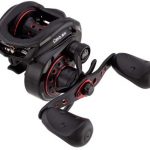 | Check Price | |
| 13 Fishing Concept Z Freshwater/Saltwater Baitcasting Fishing Reel | 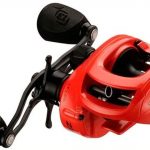 | Check Price |
What Is Light Tackle Lure Fishing?

Before you tackle the best baitcasting reel for light lures, know first what is light lure fishing. Lightweight lure fishing with soft plastics and hardwood lures in the last decade is a fishing style that has gained prominence. When you spend a lot of your time fishing with skilled and experienced anglers, many of the essential steps in this angling style’s success are obvious to you.
Select Rod and Reel
The first consideration for many fishers when buying a fishing gear is often will be strong enough to hold a big fish. The main consideration in the purchase of light tackle lure fishing equipment is easy, convenient, efficient, and accurate casting. You’ll spend much more time casting than hooking up. The attractions you throw will be light and need a balanced outfit to be cast all day long.
Fishing with the light tackle lure is often known as ‘finesse fishing.’ Light gear is essential if the targeted species are to maintain a natural presentation. The old Black Queen will not cut it consistently with a 5 kg line. If you are starting and do not want to hit a specific light lure rod, it will probably be a light trout rod in your arsenal.
But if you bite the bug, you will want to go out and buy a specific lure fishing outfit. On the market, rods and reels are designed specifically for fishing with soft plastics or hard-corpsed lures.
Spooling Up
Scratch lines have two enormous advantages when luring light. It has extra power for its diameter, which helps to find bigger fish and get them away from the tight structure. It also maintains the finesse properties for small lures. There is a big choice, so keep on proven brands, because the bad braid can be expensive and frustrating.
Having a monofilament backrest before you spray the braid has a few advantages. It first coats the braid out of the metal spool. If the cartridge is entirely spoiled with braid, it can slip under tension on the metal surface. Mono backup also saves money. Top shooting means that you don’t have to bifurcate as much money to fill a whole braid spool. Reversing the braid on the roll after an end is worn also extends its life if you are aware of the budget.
Braid is a very visible line. Monofilament or fluorocarbon leaders are necessary for the fish not to see that the interesting morsel is attached by ‘strings.’ Costly fluorocarbon has its advantages as leading material, but cheaper alternatives like light 4 to 10 lb mono are good for those who start out.
More Information
If you are put off by the entire leader/braid situation, there’s an alternative. A high-quality, low stretch mono in 4-6 lbs can be used by fishermen who target smaller species such as bream and trout. This can be helpful for the newcomer as you do not need to spoil the new knots involved in the fishing braid and learn them. Many regular tourney fishers have a fishing rod rigged with very light mono for use in extreme finesse situations.
Whether you use braid or mono, it is important to bind good knots and be vigilant when checking them. Constant casting and recovery can weaken strong knots previously. Regular checking of the knots after landing fish or brushing against underwater objects ensures that everything goes well when you jump on fish for the entire day.
Don’t fill your spool over. Too much can be seen from the slightly weighted braid loop’s spool into some unclear and costly encounters.
Choose A Lure

Lure’s choice may not be as important as it seems. Favorites change more quickly than a subcontinent cricket trainer. Magical lures are not catching fish. It is a combination of many variables and a selection of lures that leads to success. However, when making your choice, there are a few things to remember.
There is an enormous selection of attractions, including hard and soft plastic lures. An old bait or fly fishing expert will simplify the selection, otherwise helpful tackling store owners or a little research in magazines or on the internet.
Don’t go overboard; remember that one lure can only be thrown at a time. You get what you pay for again. Better to have a small selection of proven, yet costly, attractions to trust than a host of cheaper but less effective models.
More Information
What looks like on the wall of the tackle shop is much less important than in the water. Here is a clear solution. Rig the lure, put it in the water, swim, look, watch it fall. If you think something would look like a fish would eat, they will probably agree with you. It also supports a color selection by taking a few moments to test a lure. Lure colors can vary under different light and aquarelle combinations, especially for plastics.
The attraction that worked so well for you one day may not be as efficient the next time. Remember to swim and evaluate your fitness. Basically, you will try to achieve one of two things. You either want to make sure you have a natural lure that fits your environment well (usually when you fish clear water). Or else you would like to make sure that your lure is highly visible to feed fish. This is normally required in dirty water, low light, or when fish feed aggressively.
Rigging Up
Symmetry is an important concept when soft plastic is rigged. It is important to ensure that your lure lies right next to the jig-head to maintain a natural action. A lure that is not straightly rigged will twist either during the drop or when retrieved, so it does not have the enticing natural action of a goodly plastic swim. Swim again after you have tricked her into checking her action.
When you select a jig-head, two important things need to be thought about. The first is to ensure that the hook is the correct plastic size. Ensure that the hook’s gape emerges from the plastic to be placed in the mouth of the fish. The jig head’s weight should be sufficient to bring the lure down to the level of the water column you plan to fish.
Many don’t weigh enough to get the lure where the fish feed. Current fishing helps the jig-head sink rate. Drags the lure to the water column when fishing down current or behind a drifting boat, potentially away from your intended target.
The newcomer can also find a wide range of jig-heads intimidating. In short, probably the most expensive jig is your best choice. You’re just starting to expect to lose a lot of jig-heads, especially if you’re an angler. A wide range of cheaper heads is more advantageous than with a less extensive range of costly heads and sizes.
More Information
When a jig-head is attached to a leader, any standard fishing knot that locks the eye of the hook is good; however, you prefer a loop knot when attaching small, hard-bound lures to your leader. This helps small attractants to swim properly by allowing free movement.
Many of them have it for research purposes as their profession. Baiting is a fishing process in which all are ready to use the best type of fishing equipment, such as a reel, to catch the fish easily. The following are the essential tips for all types of fishers to select the best baitcasting roll for lightweight lures.
Spinning V.S. Baitcasting Reel
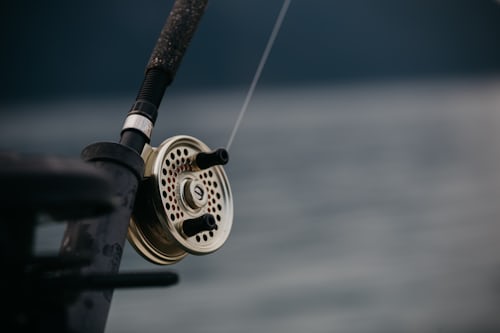
Of course, rollers have evolved exponentially, but most of them still use the same basic designs and are divided into two general categories: spinning and baitcasting, with both individual benefits and disadvantages.
Spinning Reel
Spinners are known for their easy operation and are perfect for introducing new fishers. Just flip the bail, put the finger on the line, cast the bail, and turn the handle into it. Just make sure they don’t keep the reel upside down so that you won’t make new friends. Remember: handle clockwise motion.
Spinners are especially useful when using slight attractions such as soft plastic and live attractions since the most distant cast is limited by how hard the bait is to throw. Line flows out of the spool with no drag limit and allows light attractions to start far. They’re also nice because you don’t need to worry about a spinning roll backlash.
Baitcasting Reel
At the other end of the range, bait casting reels allow cast lures like jigs, spinner knits, and crankbaits with pinpoint accuracy, but they have a dial-in drag resistance and require a higher skill set to thumb the spool while the line is off. If you can’t find this sweet thumb pressure spot, you will experience a tangled birds nest.
Generally, with a bait caster, a lure can be started further because it flows straight off the spool, rather than in circular motion like a spinning spool. However, bait casters take some time to master and practice to reach your comfort zone.
Someone with a good knowledge of casting a bait caster has a mastery of accuracy and distance after much practice and is favored when fishing sites require it. At the same time, a spinning roll can be used in virtually every situation. You definitely need the best baitcasting reel for light lures!
The Best Baitcasting Reel For Light Lures

Baitcasting reels have two main advantages over spinning reels. First of all, the reel resists the lure as it is cast. This can be done by dragging the reel internally or using the thumb pressure on the spool.
This additional resistance allows heavy lures and jigs to sprinkle in the water quietly. This is like conventional fishing rods, and these arrangements work well for jigging. The Baitcaster rod and reel combo allow for easy application of high torque and short vertical jigging movements on heavy jigs. Before you buy the best baitcasting reel for light lures, there are some things you should know.
Considerations When Buying
Here are some of the considerations when buying the best baitcasting reel for light lures. In the case of the baitcasting equipment, it is always better to consider the following factors. In fact, the best fishing bucket is very large equipment, which should be in fishermen’s hands to obtain an excellent range of fishing experience. It will be a rewarding and pleasant experience if you go fishing on the river.
There are so many models and styles of roll types on the market, and you have to choose the right and most popular choice for your needs. Baitcasting rollers are only the best choice of rolls frequently used and widely used by several professional fishers.
Because the baitcasting rods are a precise casting option, most beginners and professionals prefer to use them for various types of fisheries. These types of rollers also have the spool overrun and reduced backlash to meet the multiple fishermen’s fishing needs.
While several brands of the finest baitcasting reels on the market are available, not all of them can offer you the high quality and lasting product type for your fishing needs.
This is why it is highly recommended that every one search only for top brands with definite opinions. It is essential to consider its facts before choosing a specific brand of a baitcasting roll for your fishing needs, to ensure its durability, strength, and quality.
Meaningful Aspects Of A Baitcasting Reel

When purchasing the best baitcasting reel for light lures, it is always important to consider the following aspects.
The Ratio Of Gear
The actual speed of the baitcasting reel is also known as this particular ratio. Most popular baitcasting roll models for fishing usually have a standard ratio of 4:1. Some of the special models of the rollers have the higher gear ration, thus sacrificing the power to offer the quickest recovery. The gear ratio of the buckle will be determined actually as the total number of times a spool turns over, while the handle rotation only once at once.
The gear ratio of baitcasting rollers is essentially listed on their bodies, so it is easy to choose the right choice for your needs. When fishermen use a standard ratio of 4:1 gear on your baitcasting reel, it’s usually considered slower than the average speed of the 5:1 gear ratio. When people select the 6:1 gear ratio baitcasting roll, it’s too quick for your quick fishing activities.
Tension And Spool Size
The centrifugal and magnetic brake are usually used to adjust the tension of the spool in the reel. Some pins in the centrifuge system of this equipment can be used to adjust the spool voltage. About magnetic systems that rely on metal, such as aluminum, the magnets will be better reacted to. Fishing can certainly reduce overrun during fishing activities by adjusting the tension of the spool.
In the baitcasting rods, you can have the sticks which make the correct adjustments to ensure smooth fishing. When considering the spool’s size, the bigger and stronger fish that require the more massive lines should also matter. To get the bigger fish, you must select the larger spool for your baitcasting rolls.
More Information
In general, the centrifugal and magnetic brakes are used to tighten the tension of the spool in the baitcasting roll. Some pins in the centrifuge system of this equipment can be used to adjust the spool voltage. With regard to magnetic systems relying on aluminum, it will better react to magnet sets.
Fishers can certainly reduce overrun by adjusting the tension of the spool during fishing. In bait-casting rolls, you can have the buttons that are very useful to make appropriate adjustments to ensure smooth fishing. When considering the spool’s size, the larger and stronger fish that require the more massive lines should also matter. To get the bigger fish, you must select the larger spool for your baitcasting rolls.
Fishing Line
When it comes to the best bait caster for light lures, fishers can definitely find different lines. They generally consist of a variety of materials, including multi-filament, fluorocarbon and nylon monofilaments.
If you begin the fishing activity, because of the simple casting and backlash, it is always better for the baitcasting bags with heavier lines. At the same time, at least 0,125 inches of the spool must be empty in the reel for the fishing activities.
Handles
The handles of the baitcasting rolls used for your fishing needs must be comfortable. The soft rubber buttons or the handles must be over-dimensioned to achieve the best fishing experience. The reel and rod must be combined to make the cast and grip more comfortable.
Before choosing a particular bait casting bucket for your fisheries, tensioners, handles, drag, and thumb latches must always be tested to ensure its strength, performance, quality and everything you need to carry out your desired and successful fishing activities in the river, lake, and any other water supply.
Best Baitcasting Reel For Light Lures Reviews
Baitcasters are used most frequently for bass fishing. These buckles work well to cast and jig heavy lures. Many people use bait casts to catch catfish, walleye and hybrid stretched bass as well. Saltwater baitcasting rollers can also be applied to fish like snook, bonefish, snapper, and tarpon in canals and shallow water areas. Here is the best baitcasting reel for light lures that you should definitely check out!
Our Top Pick!
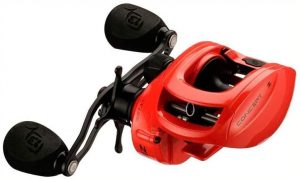
Product Name: 13 Fishing Concept Z
Product Description: The first ever high-performance casting reel manufactured with zero ball bearings. With casts that defy gravity and everything else, the Concept Z utilizes American made CZB (Concept Zero Bearing) polymer technology to deliver shocking results. This reel cast lures significantly farther than reels with traditional ball bearings. The CZB technology makes the Concept Z quiet, effortless, and controllable. Once you hook up, the 22 lb Bulldog drag and Japanese Hamai cut gearing do the rest, all you have to do is turn the handle.
-
Value For Money
-
Durability
-
Ease Of Use
-
Features
Overall
Curado Shimano DC
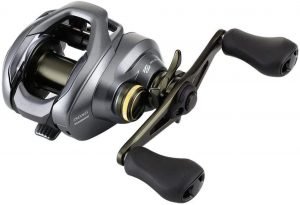
The Curado DC is the latest version of the most popular Shimano baitcasting reel ever. We could discuss how the reel is packed with roller technology, such as the Hagane alloy body, X-Ship pinion support, the micro modules, and the Cross Carbon Drag, but the star of the show was the digital I-DC4 braking system.
The I-DC4 digital braking system is a small microcontroller inside your spool. Whenever you cast the chip measures, your spool speed is 1000 a second to automatically adjust the brake pressure on the fly.
Why is it so important? It makes fishers of all levels of experience more efficient. You can now change techniques and gain weight without constantly adjusting the reel installation. Long, smooth casts can be achieved with less effort, regardless of whether you throw a light Texas Rig worm or slide a half-ounce jigs.
It may sound too good to be true, but it doesn’t. The I-DC4 is factory tuned and needs no adjustment from the box before fishing with the DC.
Shimano Chronarch MGL 150
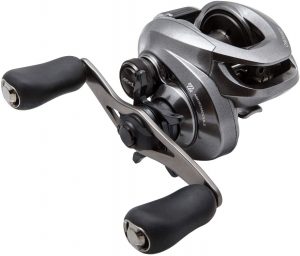
The Chronarch MGL 150 is easily placed in the top three of all bait casts. The Chronarch MGL costs more than a budgetary bucket; it costs less than the cost of magnesium framed buckets and is a premium bucket.
The Chronarch MGL is almost identical to the previous Ci4 + and still weighs just 6.5 ounces, but has some new features that are enhanced. First, like many high-end Shimano reels, the MGL is given the X-Ship gear system that provides stability and strength to the rock-solid gear.
The Micro Module Getting and MGL Spool, which names the reel, are also new. The Micro Module gears make the retrieval powerful but smooth, and the Magnumlite gear reduces casting effort up to 10%.
The Dartanium II drag washers provide one of the smoothest drag systems. You can just adjust the fish with a flick of your finger. One of the best is the SVS Infinity braking system. An external dial and four internal frequencies are calibrated by opening the lateral plate and moving 1 to 4 of the brakes.
Overall, the Chronarch MGL can be the versatile baitcasting roll you need. It’s ideal for anything from excellent lures and weightless plastics, to your flipping and pitching needs. The fact that you can achieve this performance without the price tag of a Japanese import in a lightweight carbon frame roller is a bonus.
Abu Garcia Revo SX
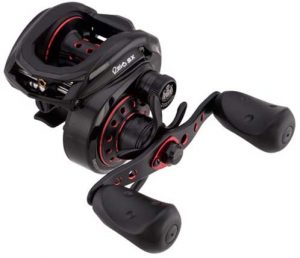
The Revo SX Abu Garcia baitcasting roller is one of today’s best all-around rollers an angler can buy. For one reason, they are Abu Garcia’s most popular baitcasting reel. It is very light, palm-friendly, and comes with two different gear ratios.
6.6:1 SX will excel in a wide variety of fishing techniques, and if you’re looking for a multi-purpose horse, we recommend it. The 7.3:1 roll, on the other hand, will be better for you when you want to burn with topwater apparel or pitch and flip jigs or soft plastic creature apparel. You’re going to get more casts in the 7.3 ratios.
The latest version of this cartridge (REVO4 SX) has a D2 Durage and clutch upgrade and a hard layer on the pinion and pawl, which is very frictional.
Thanks to 9 + 1 ball bearings and the Infini magnetic brake system on the side platform, the Revo SX is extremely smooth on the cast. If you want versatility, performance, and reliability on a new reel, this reel is an excellent choice, yet it doesn’t cost a fortune.
13 Fishing Concept Z
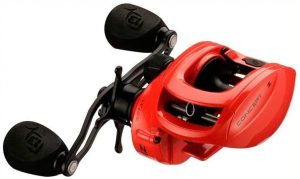
13 Fishing has always been a kind of hype for me, producing beautiful products and sprinkling. Concept Z is no exception to the “Zero Bearing” design. It is a flashy red bait caster with a matt black handle and knobs that look great. They can certainly design a god looking cartridge, but does it pass the test?
No bearings, how should that work? Concept Z uses solid polymer rollers instead of ball rollers. A robust bearing has no way to build dirt and waste to block the bearings and reduce the performance of your bobbin. This technology is impressive and has proven its hype to be true for several years now.
Concept Z has proven more than capable on the fishing side. Casting is a breeze with a unique guide for “arrowhead” and waffle spool in part. The internal centrifuge six-way brake makes it possible to cast lure up to 1 oz of crankbaits and jigs as light as 3/16 oz. One knock is the lack of external brake access, but once inside, selecting a setting form 0-6 on the dial is as easy as it is.
FAQs
Here are some of the common frequently asked questions for the best baitcasting reel for light lures.
How are you placing the drag on a baitcasting roll?
It is called the star drag on all baitcasting rolls. On the same side of the handle is a star-shaped spindle. Turning the spindle counterclockwise tightens the drag and loosens the drag in the direction of the clock. This is the adjustment that changes the spool resistance when the drop bar or spool release button has not been pressed. When the spool release button is pressed, the tension button and the magnetic brake change the resistance.
What’s the voltage control knob?
The tension control is usually a small button made of aluminum on a baitcasting cartridge. Moreover, t’s not the brake but an adjustable tension of the roller. It uses consistent pressure on the spool rather than tension based on the spool speed. An appropriate adjustment will also remove the backlash and bird nests in the line.
What is the best baitcasting rod type?
A braided fishing line is the best fishing line for a baitcasting rod. It is lightweight that helps with a long-lasting. Braided line is strong that can help to pull equipment through weeds when fishing bass. The twisted line is much less likely to reverberate when casting. Some people say it is easy to use, and people should use a monofilament line first. Monofilament line also works well with a baitcasting reel, but it provides an advantage to fish with a braided line. Fish are more visible in the braided fishing line.
Why are the PROs using baitcasting rollers?
For a number of reasons, pros use baitcasting reels. It first gives them more control of lure at both distances and how quickly the lure enters the water. Often a quiet splash is better, and a loud splash from a spinning reel is no resistance cast. Second pitching performances and bait are a quick way to accurately put pulls that are usually not done with the spinning roll.
Baitcasting rods have eyelashes facing upward and are more convenient for jigging. Finally, with heavy lines, baitcasting roll works well. A strong braided line enables the hook to be firmly fixed and large bass reeling in and netting quickly.
- For casting light lures, the right kind of baitcasting roll is essential. You are a serious angler when you read this article. You probably want a new technique to advance your skills. So it’s almost insulting to read that you need a good reel.
- If you are a seasoned bait caster, it is natural to understand how to use your thumb as a manual brake on your roll. Moreover, if you have completely turned off your magnetic brakes, this is extra important.
- If you feel the line beginning to splash away, this is an early sign of a backlash. Apply more pressure with your thumb to keep your line under control and avoid the nest of a disgusting rat.
- Your cartridge can be heavier than usual when casting light lures. Remember that you use your rod’s power to throw the bait.
Final Words
There are several features to view when selecting a baitcasting roll. The first is the ratio of equipment. Also, the gear ratio determines the line quantity, which is collected per handle turn. A low gear ratio is better for heavy jigs and high gear ratios for quickly retrieved spinners and plugs. The second is the number of lines held by the reel. It is good to get a roller containing more than 100 meters of the fishing line based on the type and pound test.
The maximum drag value is another feature to look at. The drag should be at least half the strength of the fishing line. The number of covers can be important, but the most important thing is the type of covers. Some are inexpensive and made of standard steel. Others are sealed rods with stainless steel resistant to corrosion.
In addition, the drag system and inner components can be screened to reduce corrosion inside the reel. With the variety of options on the market, making an informed choice can be quite tricky. A lot of research needs to be done to reach a good conclusion. Hopefully, this guide of best baitcasting reel for light lures can help you a lot!


